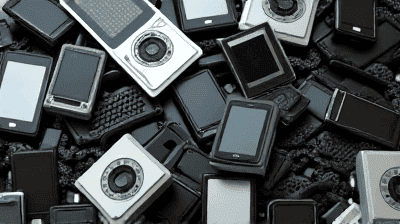The Global E-Waste Crisis: Where Do Old Phones and Laptops End Up?
The rapid advancement of technology has significantly enhanced our lives, offering unprecedented convenience and connectivity. However, this tech boom comes at a considerable cost—the growing crisis of electronic waste, commonly known as e-waste. As millions of smartphones, laptops, and other electronic devices reach the end of their useful lives, the global challenge of managing this waste continues to escalate. The United Nations estimates that global e-waste reached 53.6 million metric tons in 2019, a figure projected to grow exponentially in the coming years.
Understanding E-Waste
What is E-Waste?
E-waste encompasses a wide array of discarded electronic products, including:
- Personal Electronics: Smartphones, tablets, laptops, and desktop computers.
- Home Appliances: Televisions, microwaves, and refrigerators that contain electronic components.
- Industrial Equipment: Machinery and devices used in manufacturing and production.
- Batteries: Lithium-ion and other battery types found in electronic devices.
E-waste is characterized by its complex composition, containing valuable metals like gold and copper, as well as hazardous materials such as lead, cadmium, and mercury.
The Scale of the E-Waste Problem
The exponential growth of e-waste is fueled by several factors:
- Rapid Technological Advancements: As technology evolves, devices become obsolete quickly, with consumers frequently upgrading to the latest models.
- Increased Consumption: The rising middle class in developing countries is contributing to a surge in electronic device purchases.
- Short Product Lifespan: Many devices are designed for limited use, resulting in higher turnover rates and eventual disposal.
According to the Global E-Waste Monitor, the world generated approximately 53.6 million metric tons of e-waste in 2019, representing a 21 percent increase in just five years. This trend indicates that without effective waste management strategies, the e-waste crisis is poised to worsen.
Where Do Old Phones and Laptops End Up?
1. Landfills
One of the most common destinations for discarded electronic devices is landfills. The improper disposal of e-waste in landfills occurs for several reasons:
- Lack of Awareness: Many consumers are unaware of proper e-waste disposal methods and inadvertently throw their devices away with regular trash.
- Inadequate Collection Systems: In many regions, there are insufficient infrastructure and systems in place for the collection and recycling of e-waste.
Environmental Impact: When e-waste ends up in landfills, hazardous materials can leach into the soil and groundwater, leading to soil and water contamination. Heavy metals like lead and mercury pose significant risks to plant and animal life, disrupting ecosystems and threatening public health.
2. Informal Recycling Markets
In many developing countries, discarded electronic devices often find their way into informal recycling markets. These markets operate outside regulatory frameworks and are commonly characterized by:
- Manual Disassembly: Individuals manually dismantle devices to recover valuable metals and components, often using rudimentary tools and methods.
- Hazardous Practices: Unregulated techniques such as open burning, acid leaching, and exposure to toxic chemicals pose serious health risks for workers and surrounding communities.
Environmental and Health Risks: Informal recycling practices can lead to significant environmental contamination, releasing volatile organic compounds and heavy metals into nearby soil and air. Workers in these settings are often exposed to hazardous substances without appropriate protective measures, leading to long-term health complications.
3. Exporting E-Waste
The export of e-waste from developed countries to developing nations is another common scenario. This practice is motivated by:
- Lower Disposal Costs: Companies may choose to export e-waste to countries with less stringent environmental regulations to reduce disposal costs.
- Recovery of Raw Materials: Developing nations may offer cheaper labor and methods for recovering valuable metals from e-waste.
However, exporting e-waste raises significant ethical and environmental concerns. Many countries, especially in Africa and Asia, are ill-equipped to handle large volumes of e-waste, leading to severe consequences.
Case Study: Agbogbloshie, Ghana: Agbogbloshie has become synonymous with the informal e-waste recycling industry. Shipments of electronic devices arrive regularly, leading to the dismantling and burning of materials. The site has gained attention for its alarming levels of pollution and the dire health risks faced by local workers.
4. Authorized Recycling Centers
Although some electronic waste is properly handled, a significant amount is still processed through unregulated channels. Authorized recycling centers, which comply with environmental regulations, play a critical role in managing e-waste. These facilities typically engage in:
Responsible Collection: Collecting e-waste through drop-off locations, community events, and retailer take-back programs.
Safe Processing: Recycling and recovery of metals and components in an environmentally responsible manner, which may involve:
- Shredding: Breaking down devices to recover metals and plastics.
- Refining: Extracting valuable metals such as gold, silver, and copper through chemical and mechanical processes.
Benefits: Authorized recyclers help divert e-waste from landfills, recover valuable resources, and minimize environmental contamination.
The Environmental and Health Impacts of E-Waste
Environmental Contamination
The improper disposal of e-waste can lead to environmental degradation in various ways:
- Soil Pollution: Heavy metals and toxic substances contained in e-waste can seep into the soil, disrupting ecosystems and affecting plant growth.
- Water Contamination: When hazardous substances leach into groundwater and surface water sources, they pose significant risks to aquatic life and human health.
- Air Pollution: Burning e-waste releases harmful emissions and particulate matter into the atmosphere, contributing to air quality degradation and respiratory problems.
Human Health Risks
E-waste exposure is linked to numerous health issues, particularly for individuals working in informal recycling and disposal settings. Some key health risks include:
- Neurological Disorders: Exposure to heavy metals such as lead, mercury, and cadmium can lead to cognitive decline, developmental issues in children, and neurological disorders.
- Respiratory Problems: Inhalation of toxic fumes generated from burning e-waste can lead to respiratory issues and exacerbate preexisting conditions such as asthma.
- Reproductive Health Concerns: Certain chemicals present in e-waste, such as brominated flame retardants, have been associated with reproductive health problems and endocrine disruption.
Vulnerable Populations
Low-income communities and developing nations are often at a higher risk of exposure to e-waste hazards. Individuals living near informal recycling operations face heightened vulnerability to health risks due to limited access to healthcare and inadequate occupational safety measures.
Strategies for Mitigating the E-Waste Crisis
1. Raise Public Awareness
Increasing public awareness about the e-waste crisis is crucial for driving responsible disposal behaviors. Campaigns can focus on:
- Educational Programs: Implementing programs in schools and communities to educate individuals about e-waste and the importance of proper disposal.
- Information on Recycling Options: Providing accessible information on local recycling centers and take-back programs to encourage recycling.
2. Strengthening Regulations
Governments play a pivotal role in addressing the e-waste crisis through policies and regulations. Effective strategies may include:
- E-Waste Legislation: Enforcing strict regulations to control e-waste management, including establishing guidelines for disposal and recycling.
- Extended Producer Responsibility (EPR): Implementing EPR programs that hold manufacturers responsible for the entire lifecycle of their products, including proper disposal.
3. Promoting Sustainable Design
Encouraging manufacturers to design electronic devices with sustainability in mind can help reduce e-waste generation. Strategies may include:
- Modular Design: Creating devices that can be easily upgraded or repaired reduces the need for complete replacements.
- Use of Recyclable Materials: Utilizing materials that are easily recyclable can facilitate responsible disposal at the end of a product's life cycle.
4. Supporting Authorized Recycling Facilities
Enhancing access to authorized recycling centers is essential for safe e-waste disposal. Steps may include:
- Increasing Collection Points: Expanding the number of drop-off locations and retailer take-back programs for consumers.
- Investment in Infrastructure: Supporting the development of specialized recycling facilities that can safely process e-waste.
5. Engaging in International Collaboration
The global nature of the e-waste crisis necessitates international cooperation and collaboration. Potential strategies may involve:
- Sharing Best Practices: Countries can share successful strategies for e-waste management, taking into account local contexts.
- Strengthening Trade Regulations: International agreements can be established to restrict the export of e-waste to countries lacking the capacity to handle it safely.
Innovative Solutions to the E-Waste Crisis
1. E-Waste Recycling Technologies
Advancements in recycling technology have the potential to improve the efficiency and effectiveness of e-waste processing. Innovations may include:
- Hydrometallurgical Techniques: Using chemical processes to recover valuable metals from e-waste while minimizing environmental impacts.
- Artificial Intelligence (AI): AI systems can optimize sorting processes in recycling facilities, enhancing the recovery of valuable materials.
2. Circular Economy Initiatives
Incorporating circular economy principles into electronic product design and consumption can significantly reduce e-waste generation. Key aspects of this approach include:
- Repair and Reuse: Encouraging the repair of devices rather than replacement extends their lifespan and reduces waste.
- Product-as-a-Service: Shifting towards business models where businesses retain ownership of devices, promoting repair, refurbishment, and recycling.
3. Community-Based Recycling Programs
Grassroots initiatives can empower communities to take action. Strategies may include:
- Local E-Waste Collection Events: Organizing community events to safely collect and recycle e-waste, fostering community engagement and awareness.
- Workshops and Training: Offering workshops on device repair and recycling techniques can help reduce waste and encourage responsible disposal.
Case Studies of Successful E-Waste Management
1. The European Union's WEEE Directive
The European Union has instituted the Waste Electrical and Electronic Equipment (WEEE) Directive to promote e-waste recycling and reduce its environmental impact. Key features include:
- Extended Producer Responsibility (EPR): Manufacturers are required to take responsibility for the collection, treatment, and recycling of their products.
- Collection Targets: Member states must achieve specific collection targets for e-waste, promoting responsible disposal practices.
Outcome: The WEEE Directive has led to increased e-waste collection rates across Europe, promoting environmentally sound recycling practices.
2. The U.S. National Product Stewardship Strategy
In the United States, various states have implemented product stewardship programs for electronic devices. These initiatives involve:
- State-Level Policies: Regulations that require electronics manufacturers to establish collection programs and manage recycling efforts.
- Consumer Education: Campaigns to educate consumers about proper e-waste disposal methods.
Outcome: These efforts have resulted in increased awareness and participation in e-waste recycling programs at the state level.
The Future of E-Waste Management
As the global population continues to grow and technology evolves, the challenge of e-waste management will remain a pressing issue. However, innovative strategies and initiatives offer hope for a more sustainable and responsible approach to managing electronic waste.
1. Increasing Industry Involvement
The electronics industry has a critical role to play in addressing the e-waste crisis. Efforts to engage manufacturers in e-waste management can include:
- Collaboration on Recycling Initiatives: Joint efforts between manufacturers to establish efficient recycling systems and shared resources for collection.
- Sustainable Practices: Encouraging companies to adopt environmentally friendly practices in their manufacturing processes and supply chains.
2. Educational Institutions
Educational institutions can contribute by integrating e-waste awareness into their curricula. Potential initiatives may involve:
- Research Projects: Encouraging students to engage in research on e-waste management and develop innovative solutions for recycling and disposal.
- Community Outreach: Leveraging partnerships to educate local communities about the importance of responsible e-waste disposal.
3. Technological Innovation
The advancement of technology will continue to shape the future of e-waste management. Innovations may include:
- Blockchain for Tracking E-Waste: Utilizing blockchain technology to enhance transparency and accountability in e-waste recycling processes.
- Smart Devices: Developing smart devices that can alert users when repairs are possible, extending the lifespan of products.
4. Global Collaboration and Policy Development
In light of the global nature of the e-waste crisis, collaboration among nations, NGOs, and industry stakeholders will be vital. Initiatives may include:
- Global Treaties on E-Waste: International agreements to regulate the export and disposal of e-waste, ensuring responsible management practices worldwide.
- Best Practice Sharing: Collaborative platforms for countries to share effective strategies for e-waste management and recycling.
Conclusion
The global e-waste crisis presents a multifaceted challenge that requires concerted efforts from individuals, communities, industries, and governments alike. As old phones and laptops are discarded, where they end up poses significant implications for both environmental health and human safety. By understanding the complexities of e-waste and its fate, we can drive awareness, advocate for proper disposal and recycling practices, and promote innovative solutions that address this pressing challenge.
Achieving effective e-waste management will ultimately rely on a collective commitment to sustainability, responsibility, and environmental stewardship. Through education, policy implementation, technological advancement, and community involvement, we can pave the way towards a more sustainable future—one where the valuable resources embedded in electronic devices are preserved, and the harmful effects of e-waste are effectively managed.



